Archive
Commodore 8032 / CompuThink Disk Drive / Woltron ROM-BUS

Commodore CBM 8032 (HP – Early version 1980) – CompuThink Disk Drive Controller – External Dual Disk Drive – Woltron ROM-BUS Adapter.
- COMPU/THINK (CompuThink) Dual Disk Drive Controller with 8k RAM per commodore PET 8032 (It could be a Prototype or a Clone Board with ASSY 001-35 – DD DSK CTL COMP).
- COMPU/THINK External Dual Disk Drive 800k DD/DS.
- WOLTRON ROM (CompuThink C-DOS & TOOLKit) + PET/CBM Expansion BUS Adapter + PIA (Peripheral Interface Adapter) Motorola MC6821.
Unfortunately there is no documentation on the net of this Computhink card that seems to be a prototype or a clone, also there is no documentation or photos of the BUS/ROM Adapter by Woltron.
I spent sleepless nights looking for the starting SYS for the disk management software on the eprom, i have disassembled 24k of code (C-DOS Roms / Basic Roms Patched / Edit Roms Patched) in machine language.
I did it and found it the starting sys ($E790 – SYS 59280), although everything seems to work perfectly after the sys command is printed on the screen (*DOS-40*) and by typing the directory command ($d,1) or the format command ($f,1) the floppy starts to run correctly but the head does not move, while the exit command ($h) work correctly,
i need to say that i replaced the FDC1791 and some floppy disk logic and also one floppy disk drive, but nothing changed.
My suspicion falls on the PROM 82S123 there is no dump on the net, reading this PROM of 32 bytes, only the first 8 Bytes are filled, this is right ? we’ll never know.
All EPROM and PROM have been dumped and you can find them in the archive below.
Gallery:
Download: C-DOS 4.0 - Basic/Edit Roms Patched - PROM 82S123 (1055)
Commodore MMF 9000 (SuperPET 9000) Repair & Testing
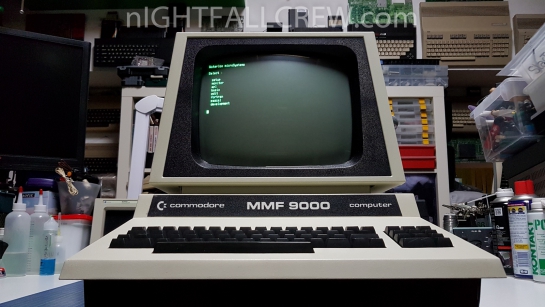
The SuperPET is a Commodore PET 8032 with one or two added boards that were designed at the University of Waterloo.
The computer has a built-in RS-232C interface and many programming languages on Floppy Disk. In Europe, this machine was called the MicroMainFrame 9000, or MMF 9000.
Let’s start to assembling the BMB Compuscience Ltd Board and Compu-Think 64K Memory Expansion board in the Commodore MMF 9000 (SuperPET)
I had to shorten the original standoffs installed in the computer because the length was wrong for the two boards BMB Compuscience/Compu-Think 64K. The long standoffs are used for the superPET Combo Board (the last one released).
It was not a simple job, obviously i have looked around for the identical standoffs with thickness, size, pitch and some with a long screw other with a short screw.
Between one phase and another i have also giving a nice clean inside and outside of the computer and of the motherboard.
Unfortunately there are a couple of problems after assembling the two boards of the MMF 9000 (SuperPET).
Defects:
- The keyboard space bar dead.
- Don’t runs any Waterloo program in the 6809 environment, runs only the Bootstrap menu which allows to load the programs from Floppy Disk, the Machine Language monitor and the Setup program both are in the Eprom.
- The protection Dongle (6702) not correctly viewed from the system.
Repair/Fix:
- The keyboard after a good cleaning has started to work well.
- The Dongle after cleaning the contacts now works.
About the programs that don’t runs in the 6809 environment the repair was a bit longer. I have used the only program that worked under the 6809 environment, the Machine Language Monitor.
With this program i have filled the memory with the command Fill (f 9000-9fff aa) and i have changed from time to time the bytes that i was going to write in memory and i have used the command (d 9000-) to see the results and not all memory locations are written correctly.
With the Bank Switching command (b 0, b 1 …) i have switch the memory bank, there are 16 banks of 4k each for a total of 64k.
I have found 7 x 4116 RAM failed (this card is new, never used), replaced these bad RAMs everything has started to work properly.
So my advice is to try to load the Waterloo software in the 6809 environment to make sure that the 64k memory expansion (only seen in the 6809 environment) is working properly.
Below the photos of all the tests that i have done:
- Test with the CPU 6502 (Standard Commodore 8032/32k) with disk access, some software running in emulation 40 columns with the program: 80240.prg
- Test with the CPU 6809 of the entire Waterloo software package with disk access.
Gallery:
This is a archive with documents, disk images and rom files usefully to test the computer.
Download: MMF9000/SuperPET Documents,Disk images,ROM Files (1347)
Commodore PET 2001 Japanese Instruction Manual
Commodore CBM 4008
The Commodore PET 4000 series features Basic 4.0 as a standard feature, along with more memory and a lower price that made them attractive to schools.
Elementary, Middle, and High Schools all over Canada and the United States were filled with these impressive lumbering beasts. Introducing children far and wide to the wonders of BASIC programming. Another lesson taught was the importance of patience, since many schools provided only a tape datasette for loading and saving work.
Like the other models of PET, the 4000 series includes dual datasette ports, though only one is exposed to the outside of the casing. A standard IEEE-488 interface in the back allows the PET to connect to the numerous (and heavy) disk drives and printers being produced by Commodore and other manufacturers.
The PET also has a fully programmable bi-directional parallel interface called the “User” port, which allows the PET to connect and control almost any device one could dream up! The greatest feature, however, is the friendly READY prompt, and the well-laid out keyboard with graphic characters only a keypress away! Pictured here is the PET 4016.
Interestingly, although Commodore provided 8, 16, and 32k versions of their PET 2001 and 3001 series, they had a hard time getting people to purchase higher memory versions as an upgrade. It seemed that people were soldering in their own memory chips onto PET 2001 and 3001 8k and 16k models to upgrade them to 32k. To help prevent this, Commodore sold many PET 4008 and PET 4016 models with the empty memory sockets punched out and destroyed! This encouraged those who wanted more memory to upgrade to the 4032 instead of doing it themselves.
Gallery:
source: zimmers.net
Commodore PET 2001-8C (Chiclet): Brothers of the same father

These are my two Commodore PET 2001-8C (Chiclet). They are two different models, below i will list the differences.
On the left:
- Different front Label.
- PET Motherboard ASSY 320132
- Different Copyright Label on motherboard (1978)
- Uses the 2114 ram ic for the Main memory and for the Video ram.
- CRT tube with green phosphor.
- The transformer, the big electrolytic capacitor and the power connector are different.
- Datassette Motherboard ASSY 320275-B (1978)
On the right:
- Different front Label.
- Motherboard ASSY 320008
- Different Copyright Label on motherboard (1977)
- Uses the MOS 6550 ram ic for the Main memory and for the Video ram.
- CRT tube with white phosphor.
- The transformer, the big electrolytic capacitor and the power connector are different.
- Datassette Motherboard ASSY 320109.E (1977)
Commodore PET 2001-8C (Chiclet Keyboard) MOS 6550 Ram version
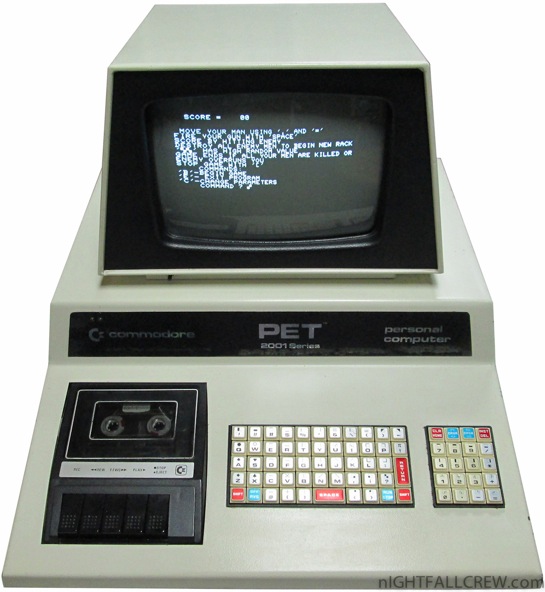
This Commodore PET 2001-8C also includes a homemade Power Amplifier to hear the sound of some games that use the pin CB2 of the User Port as audio output.
Also is included a reset button and two mini-led (Red / Green) that display the data (Save / Load) when using the tape recorder.
Some photos of the Commodore PET 2001-8C:
Copyright label on the motherboard:

Some photos of the repairing and cleaning:
Commodore PET 2001 (Chicklet) Repair datassette.
Defects:
- Doesn’t load any more.
Repair:
- Replace motor.
- Replace belt.
- Azimuth adjustment.
Thanks to Manosoft for the spare parts (white datassette, the same model of the black one)
Commodore PET 2001 (Chicklet) Repair.
Defects:
- Wrong chars on the screen.
- Memory problems.
Repair:
- Replaced all MOS 6550 main ram with an 6550 Ram Adapter by xAD & Manosoft (only 2 x MOS 6550 was faults)
- Replaced 1 x MOS 6550 Video Ram with a spare one from the main ram.
Video of Galaxy Invaders with Sounds:
from Wikipedia homepage:
The Commodore PET (Personal Electronic Transactor) was a home/personal computer produced in 1977 by Commodore International. A top-seller in the Canadian and United States educational markets, it was Commodore’s first full-featured computer, and formed the basis for their entire 8-bit product line.
Commodore PET(CBM) 3032 Repair
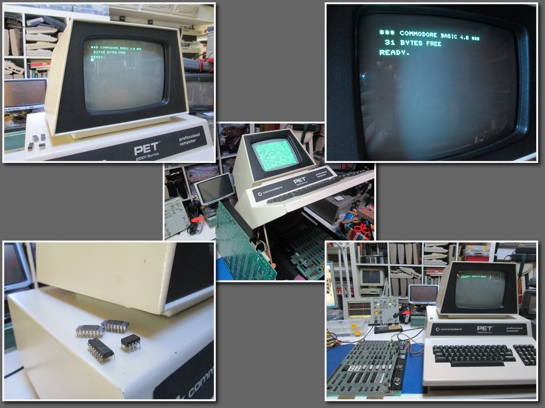
Commodore CBM/PET 3032 Motherboard Repair.
Defect:
- Garbled screen and then “Illegal Quantity Error” message or 31 Bytes free
Replaced parts:
- Replaced 1 x NE555 (A2)
- Replaced 2 x Unstable RAM 4116 (I2/I3)
- Replaced 1 x 74LS153 (E4)
Repaired for a friend a Commodore CBM 8296 Motherboard

Repaired for a friend a Commodore CBM 8296 Motherboard.
Defect:
- Black screen of death without startup beep.
Replaced parts:
- Replaced PLA [UE6] with a OTP EPROM 27C512R 70ns + Adapter.
- Replaced PLA [UE5] with a original one MOS 324744-01
- Replaced [UC8] 3-State Driver Bus MOS 65245 (74LS245)
Restoring & Repair a Commodore 8296 (TAN Case)
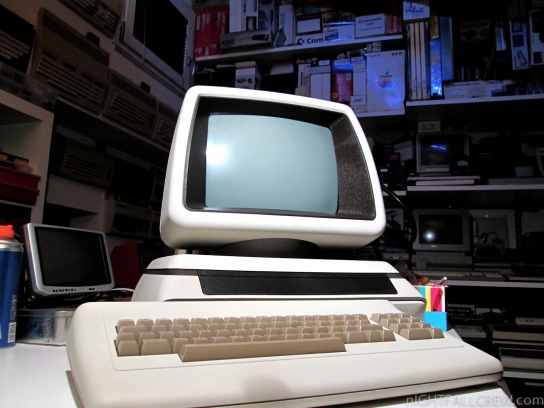
The conditions of this Commodore 8296 (TAN Case) are really bad. The CBM 8296 is left for over 25 years in a dovecote.
The cleaning, repairing and restoration have taken a very long time, but the result is more than acceptable.
Defects:
- The Commodore 8296 was completely dead (Black screen of death).
- Little problems of CRT geometry.
Replaced parts:
- Replaced PLA U6 with a OTP EPROM 27C512R 70ns + Adapter
- Replaced the ROM 2 x 2764 Eprom with 1 x 27C128 Eprom (spare parts from a original cbm pcb)
Note:
I have replaced the original ROM (2 x EPROM) pcb because the PLA adapter is fat. I could insert a small castle (photo) between the ROM pcb and the Main Motherboard but in this time i have prefered to replace with a single Eprom.
Gallery of repair and cleaning:
Repaired for a friend a Commodore CBM 8296-D Motherboard
This is a Commodore CBM 8296-D Motherboard repaired for a Friend.
Gallery of the repair:
Defect:
- Black screen of death without startup beep and after replacing U5 and U6 black screen of death with startup beep.
Replaced parts:
- Replaced PLA U5 with a original PLA MOS 324745-01.
- Replaced PLA U6 with a OTP EPROM 27C512R 70ns + Adapter
- Replaced a dual FlipFlop 74LS74 UD4.
* The replacement of the two PLA has already been made earlier by my friend.
Restoration & Repair of a Commodore 8032-SK (Gold Label)
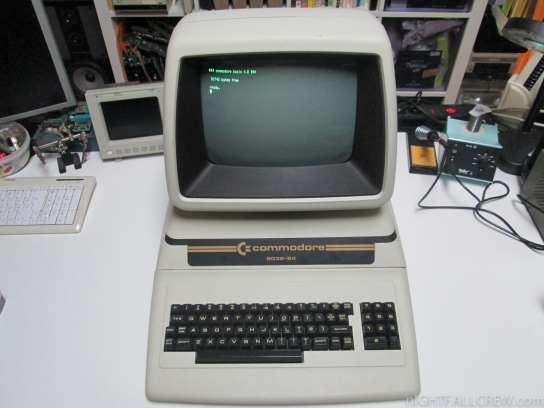
The conditions of this Commodore 8032-SK (Gold Label) are really bad. The CBM 8032-SK is left for over 25 years in a dovecote.
The cleaning, repairing and restoration have taken a very long time, but the result is more than acceptable.
Defects:
- The Commodore 8032-SK was completely dead (Black screen of death).
- Little problems of CRT geometry.
Repair:
- Replaced the CPU 6502.
- Yoke calibration of the CRT
Gallery of repair and cleaning:
Cleaning & Repairing a Commodore PET 2001-8C
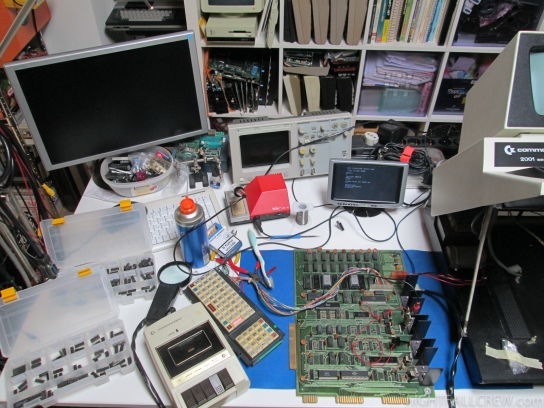
This gallery shows some stages of repairing the Commodore PET 2001-8C
Two months have passed since i have received my Commodore PET 2001-8 Chicklet exchanged for a Sharp MZ-80K, was the day 28/08/2013.
The motherboard was in disastrous conditions, it took two months and a lot of patience to repair it.
Defect:
- Garbled characters at boot.
- Tape Recorder (Datassette) Motor Tired.
Replaced parts and various repairs:
A large number of short circuits visible and not visible (under the ic sockets)
- 2 x 6540 ROM Basic 1.0
- 2 x 74LS00
- 3 x 74LS157
- 1 x 7805
- 2 x Electrolytic Capacitor / Tantalum.
- 1 x Tape Motor
- 16 x 2114 RAM
I want to dwell on the ram, i noticed that the PET 2001-8 Chicklet does not digest very well all ram.
These ram don’t work properly for my PET 2001-8 Chicklet:
- TESLA 2114 (2/8)
- MM2214N
- SY2114-2
- HKE2114L-2
I had to buy several stocks of ram in 2114 to find the right ram that work correctly. The ram that work very well are the ELCAP 2114L-3.
I have to thank Andrea Pierdomenico for the ROM test on his PET 2001-8C and Alessandro Polito. for the exchange.
Commodore PET 2001-8C (Chiclet Keyboard)
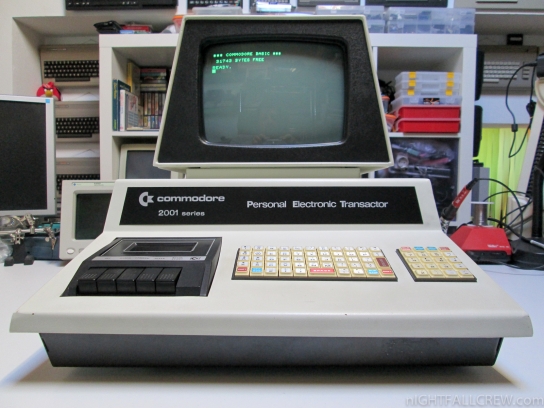
Autopsy:
This Commodore PET 2001 also includes the Expansion Memory ExpandaMem made by CompuThink
from Wikipedia homepage:
The Commodore PET (Personal Electronic Transactor) was a home/personal computer produced in 1977 by Commodore International. A top-seller in the Canadian and United States educational markets, it was Commodore’s first full-featured computer, and formed the basis for their entire 8-bit product line.
In the 1970s Commodore was one of many electronics companies selling calculators designed around Dallas-based Texas Instruments (TI) CPU chips. However, in 1975 TI increased the price of these components to the point where the chip set cost more than an entire TI calculator, and the industry that had built up around it was frozen out of the market.
Commodore responded to this by searching for a chip set they could purchase outright. They quickly found MOS Technology, who were in the process of bringing their 6502 microprocessor design to market, and with whom came Chuck Peddle’s KIM-1 design, a small computer kit based on the 6502. At Commodore, Peddle convinced Jack Tramiel that calculators were a dead-end. In September 1976 Peddle got a demonstration of Jobs and Wozniak’s Apple II prototype, when Jobs was offering to sell it to Commodore, but Commodore considered Jobs’ offer too expensive.
Tramiel demanded that Peddle, Bill Seiler, and John Feagans create a computer in time for the June 1977 Consumer Electronics Show, and gave them six months to do it. Tramiel’s son, Leonard, helped design the PETSCII graphic characters and acted as quality control. The result was the first all-in-one home computer, the PET, the first model of which was the PET 2001. Its 6502 processor controlled the screen, keyboard, cassette tape recorders and any peripherals connected to one of the computer’s several expansion ports. The PET 2001 included either 4 kB (2001-4) or 8 kB (2001-8) of 8-bit RAM, and was essentially a single-board computer with discrete logic driving a small built-in monochrome monitor with 40×25 character graphics, enclosed in a sheet metal case that reflected Commodore’s background as a manufacturer of office equipment. Designed on an appliance computer philosophy similar to the original Macintosh the machine also included a built-in Datassette for data storage located on the front of the case, which left little room for the keyboard.
The data transfer rate to cassette tape was 1500 baud, but the data was recorded to tape twice for safety, giving an effective rate of 750 baud. The computer’s main board carried four expansion ports: extra memory, a second cassette tape recorder interface, a parallel port (mainly used for disk drives and printers) and an IEEE-488 port (mainly used for modems).
The PET 2001 was announced at the Winter CES in January 1977 and the first 100 units were shipped later that year in October. However, the PET was back-ordered for months and to ease deliveries, early in 1978 Commodore decided to cancel the 4 kB version (also because the user would be left with barely 3 kB of RAM).
source: wikipedia
Repairing a Commodore CBM 610
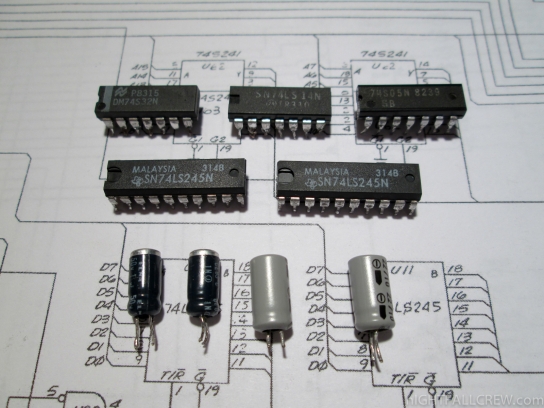
This gallery shows some stages of repairing the Commodore CBM 610.
Defects found on the Commodore CBM 610:
- Random raster lines on the screen.
Components replaced:
- 2 x 74LS245
- 1 x 74S32
- 1 x 74S05
- 1 X 74LS14
- 2 x Capacitor 22uf 10v
- 2 x Capacitor 1uf 50v
I have passed three weeks of suffering for repairing this CBM 610. The finding of the fault is not has been easy, the key component of the failure was the IC 74S05 (U96) followed by the other components.























































































































































Recent Comments